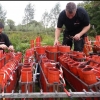
3 inch shells
#1

Posted 18 August 2012 - 11:38 AM
I'm still early stages of learning the art of making shells I'm really concentrating on 2 or 3 inch ones. In particular 3 inch and I'm trying to get my testing as accurate as possible with like for like stars and build technique.
I'm working with exactly the same stars which are supposed to be easy to light and they dry rock hard which seemed like a good idea if I was going to be trying to break the shells nice and hard. I opted for a pearl streamer stars which are just a basic Zinc based star with a simple BP prime (CIA method plus some silicon).
I've then made some KP coated rice crispies (I find they coat so much easier than hulls) using about 7 to 1 ration and then done the same with my CIA BP. My goal was to test shells using BP coated and KP coated crispies.
I then made 2 shells both with the same amount of crispies (1 with BP and one KP) and I boosted each with about a large teaspoon of Benzolift ( prefer this to flash or whistle mix on it's own as it's safer to make). Each shell was built using paper hemis and 6 layers of self gummed tape using the three strip method.
So tested last night and the BP shell broke nicely, hard but not ridiculously so but even so some stars did not light. For the stars that did light (this was most of them to be honest) I could clearly see the prime ignite but the Zinc star did not. At the time I just thought the prime wasn't man enough for the job or they broke too fast for the prime to do it's job. Also just FYI the prime layer was probably a bit thicker than it should have been and actually gave quite an effect on its own!
So anyway I launch the KP shell and the break is really really very hard and perfectly round. It broke quite a lot harder than the BP shell which didn't surprise me but what did was that all the stars lit and even the Zinc star cores lit this time.
Sorry to go into so much detail but I felt lot of this background is important.
What I can't understand how the second shell performed better when it broke so much harder. The only thing I can think of is that the KP burned hotter and ignited the stars fully before the break but I'm not basing that on anything other than a guess. Is it possible that the BP prime ignited more fully all around he star due to the KP?
#2

Posted 18 August 2012 - 01:32 PM
Firstly yes maybe the KP faster and hotter burst gave them a " boost" to light however if the ones in the bp burst
lit the prime then this is not the case.
I suspect the harder and faster burst made the prime hotter as the stars were thrown across the sky. Think of a length of wood used as a torch, you take the tip and put it in the fire, let it get hot and burning, take it out and the flame dies however the embres are stil smouldering, you wave this and it gets hotter and hotter until it re-ignites bursting into flames. This is the way some primes work and it can only help to have more oxygen flowing over the surface of a prime containing silicon, hence why the faster, harder break helped the prime do its thing.
Try single shot tests with a comet " gun" use slow bp to lift, then a faster bp, then something abit fast etc etc you should see the slower lifts not ignite the zink star but the fast ones should, I have had this exact problem however the stars worked great in the gun test and did not in the shells, I suspect the shells did not break hard enough in 3" but in 5" they were fine so again there is definantly something to do with burst speeds, smolder/prime temps. If you want you could use a hotter prime or a 2 stage prime.
I have stopped experimenting nowadays as it got me really frustated, when crafting these beautifull looking shells then they do not perform its abit dis-heartening. Any ways hope this helps, its from my own experience not sure if theory or science can back it up.
Jason
#3

Posted 18 August 2012 - 01:35 PM
#4

Posted 18 August 2012 - 05:16 PM
The 2nd KP shell was almost perfect but I suspect my problem is my prime. I'm actually encouraged by the simple fact that the KP coated crispies worked so well even if I had used a hefty dollop of Benzolift. I think I can cut back on the boost a bit for the next tests and certainly for the willow effects maybe get rid of it completely. If I use the exact same batch of stars for a less boosted KP shell then that might tell me more about the speed effect on the stars ability to light correctly.
Now that I have a reliable technique for building the shell and getting it to break just how I wanted I can concentrate on getting all the stars to light. Personally I find the temptation is to try too many different formula stars and you end up not making good notes on what worked or didn't work with what prime.
I now what you mean by it being a bit dis-heartening but I guess I'm quite a patient person. I've always been into hobby models and I like the building aspects of it. I even find shell pasting quite therapeutic lol.
#5

Posted 20 August 2012 - 12:44 PM
#6

Posted 20 August 2012 - 05:28 PM
Rod
#7

Posted 20 August 2012 - 07:48 PM
Ron Lancaster gives a similar prime in his book P246 Potassium nitrate 40% silicon 300 mesh 40% and gunpowder 20% for igniting barium nitrate/ aluminium waterfalls and stars.
Rod
I tried that but found it didn't always light in fast propelled stars, so upped the amount of gunpowder considerably. Would be fine for waterfalls though I'm sure
#8

Posted 24 August 2012 - 11:20 PM
Ron Lancaster gives a similar prime in his book P246 Potassium nitrate 40% silicon 300 mesh 40% and gunpowder 20% for igniting barium nitrate/ aluminium waterfalls and stars.
Rod
That's the prime I use for everything these days. It reliably lights barium nitrate stars that blow blind with most other primes.
1 user(s) are reading this topic
0 members, 1 guests, 0 anonymous users













